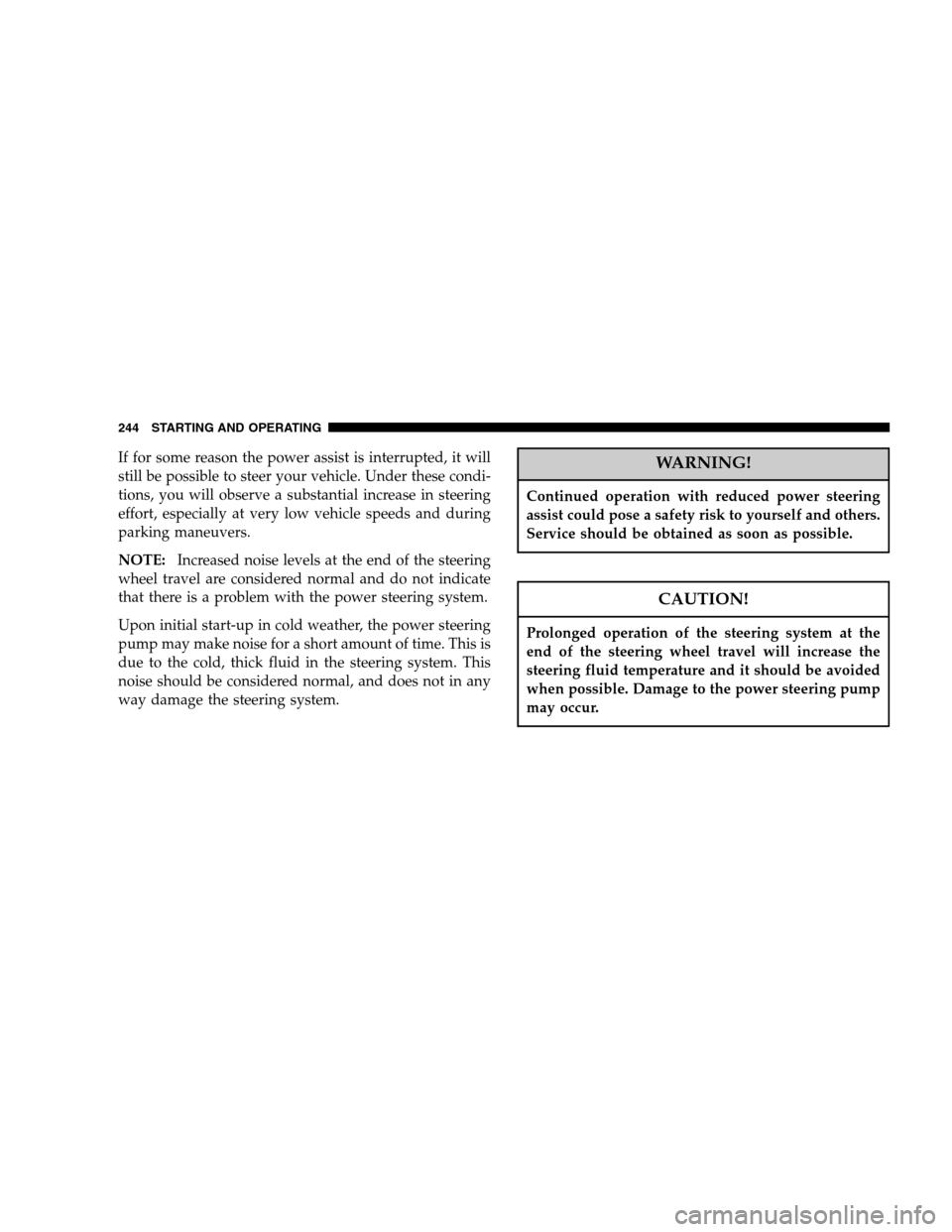Page 177 of 417

Electrical Disturbances
Radio waves may pick up electrical disturbances during
transmission. They mainly affect the wave amplitude,
and thus remain a part of the AM reception. They
interfere very little with the frequency variations that
carry the FM signal.
AM Reception
AM sound is based on wave amplitude, so AM reception
can be disrupted by such things as lightning, power lines
and neon signs.
FM Reception
Because FM transmission is based on frequency varia-
tions, interference that consists of amplitude variations
can be filtered out, leaving the reception relatively clear,
which is the major feature of FM radio.
NOTE:The radio, steering wheel radio controls (if
equipped), and 6 disc CD/DVD changer (if equipped)will remain active for up to 10 minutes after the ignition
switch has been turned off. Opening a vehicle front door
will cancel this feature.
SALES CODE RBK — AM/ FM STEREO RADIO
WITH CD PLAYER AND CD CHANGER
CONTROLS
NOTE:The radio sales code is located on the lower left
side of your radio faceplate.
RBK Radio
UNDERSTANDING YOUR INSTRUMENT PANEL 177
4
Page 200 of 417
REMOTE SOUND SYSTEM CONTROLS — IF
EQUIPPED
The remote sound system controls are located on the rear
surface of the steering wheel. Reach behind the wheel to
access the switches.The right hand control is a rocker type switch with a
push-button in the center and controls the volume and
mode of the sound system. Pressing the top of the rocker
switch will increase the volume and pressing the bottom
of the rocker switch will decrease the volume.
Pressing the center button will make the radio switch
between the various modes available (AM/FM/TAPE/
CD, Etc.).
The left hand control is a rocker type switch with a
push-button in the center. The function of the left hand
control is different depending on which mode you are in.
The following describes the left hand control operation in
each mode.
200 UNDERSTANDING YOUR INSTRUMENT PANEL
Page 239 of 417

•Completely inspect the underbody of your vehicle.
Check tires, body structure, steering, suspension, and
exhaust system for damage.
•Check threaded fasteners for looseness, particularly on
the chassis, drivetrain components, steering, and sus-
pension. Retighten them, if required, and torque to the
values specified in the Service Manual.
•Check for accumulations of plants or brush. These
things could be a fire hazard. They might hide damage
to fuel lines, brake hoses, axle pinion seals, and
propeller shafts.
•After extended operation in mud, sand, water, or
similar dirty conditions, have brake rotors, wheels,
brake linings, and axle yokes inspected and cleaned as
soon as possible.
WARNING!
Abrasive material in any part of the brakes may
cause excessive wear or unpredictable braking. You
might not have full braking power when you need it
to prevent an accident. If you have been operating
your vehicle in dirty conditions, get your brakes
checked and cleaned as necessary.
•If you experience unusual vibration after driving in
mud, slush or similar conditions, check the wheels for
impacted material. Impacted material can cause a
wheel imbalance and freeing the wheels of it will
correct the situation.
STARTING AND OPERATING 239
5
Page 244 of 417

If for some reason the power assist is interrupted, it will
still be possible to steer your vehicle. Under these condi-
tions, you will observe a substantial increase in steering
effort, especially at very low vehicle speeds and during
parking maneuvers.
NOTE:Increased noise levels at the end of the steering
wheel travel are considered normal and do not indicate
that there is a problem with the power steering system.
Upon initial start-up in cold weather, the power steering
pump may make noise for a short amount of time. This is
due to the cold, thick fluid in the steering system. This
noise should be considered normal, and does not in any
way damage the steering system.WARNING!
Continued operation with reduced power steering
assist could pose a safety risk to yourself and others.
Service should be obtained as soon as possible.
CAUTION!
Prolonged operation of the steering system at the
end of the steering wheel travel will increase the
steering fluid temperature and it should be avoided
when possible. Damage to the power steering pump
may occur.
244 STARTING AND OPERATING
Page 259 of 417

Replacement Tires
The tires on your new vehicle provide a balance of many
characteristics. They should be inspected regularly for
wear and correct cold tire inflation pressure. The manu-
facturer strongly recommends that you use tires equiva-
lent to the originals in size, quality and performance
when replacement is needed (see the paragraph on tread
wear indicators). Refer to the Tire and Loading Informa-
tion placard for the size designation of your tire. The
service description and load identification will be found
on the original equipment tire. Failure to use equivalent
replacement tires may adversely affect the safety, han-
dling, and ride of your vehicle. We recommend that you
contact your original equipment or an authorized tire
dealer with any questions you may have on tire specifi-
cations or capability.WARNING!
•Do not use a tire, wheel size or rating other than
that specified for your vehicle. Some combina-
tions of unapproved tires and wheels may change
suspension dimensions and performance charac-
teristics, resulting in changes to steering, han-
dling, and braking of your vehicle. This can cause
unpredictable handling and stress to steering and
suspension components. You could lose control
and have an accident resulting in serious injury or
death. Use only the tire and wheel sizes with load
ratings approved for your vehicle.
•Never use a tire with a smaller load index or
capacity, other than what was originally equipped
on your vehicle. Using a tire with a smaller load
index could result in tire overloading and failure.
You could lose control and have an accident.
•Failure to equip your vehicle with tires having
adequate speed capability can result in sudden
tire failure and loss of vehicle control.
STARTING AND OPERATING 259
5
Page 291 of 417

WARNING!
Improper towing can lead to an injury accident.
Follow these guidelines to make your trailer towing
as safe as possible:
Make certain that the load is secured in the trailer
and will not shift during travel. When trailering
cargo that is not fully secured, dynamic load shifts
can occur that may be difficult for the driver to
control. You could lose control of your vehicle and
have an accident.
•When hauling cargo or towing a trailer, do not over-
load your vehicle or trailer. Overloading can cause a
loss of control, poor performance or damage to brakes,
axle, engine, transmission, steering, suspension, chas-
sis structure or tires.
•Safety chains must always be used between your
vehicle and trailer. Always connect the chains to the
frame or hook retainers of the vehicle hitch. Cross the
chains under the trailer tongue and allow enough
slack for turning corners.
•Vehicles with trailers should not be parked on a grade.
When parking, apply the parking brake on the tow
vehicle. Put the tow vehicle automatic transmission in
P for Park. With a manual transmission, shift the
transmission into reverse. And with four-wheel-drive
vehicles, make sure the transfer case is not in neutral.
Always, block or�chock�the trailer wheels.
•GCWR must not be exceeded.
•Total weight must be distributed between the tow
vehicle and the trailer such that the following four
ratings are not exceeded:
1. GVWR
STARTING AND OPERATING 291
5
Page 405 of 417

Filters
Air Cleaner.......................... 324
Engine Oil........................... 323
Engine Oil Disposal.................... 323
FinishCare ............................ 348
Flashers
Hazard Warning....................... 302
Turn Signal.....................166,363,365
Flooded Engine Starting................... 213
Fluid Capacities......................... 366
Fluid Leaks............................. 76
Fluid Level Checks....................... 76
Automatic Transmission................. 345
Clutch Fluid.......................... 342
Engine Oil........................... 320
Manual Transmission................... 344
Power Steering........................ 330
Fluids, Lubricants and Genuine Parts.......... 367
Fog Light Service........................ 364Fog Lights.......................... 118,364
Folding Rear Seat........................ 113
Four Wheel Drive....................... 226
Operation........................... 226
Shifting ..........................228,232
Systems..........................226,229
Four-Way Hazard Flasher.................. 302
FrontAxle(Differential) ................... 342
Fuel................................. 273
Filler Cap (Gas Cap).................... 277
Gasoline............................ 273
Gauge.............................. 173
Hoses.............................. 339
Materials Added....................... 275
Octane Rating........................ 273
Requirements......................273,366
System Hoses......................... 339
Tank Capacity........................ 366
Fuel System Caution................275,278,279
INDEX 405
10
Page 409 of 417

Rear Servicing........................ 365
Rear Tail............................ 365
Seat Belt Reminder..................... 173
Security Alarm (Theft Alarm).............. 172
Sentry Key........................... 172
Service.............................. 362
Side Marker.......................... 365
Tire Pressure Monitoring (TPMS)........... 166
Traction Control....................130,175
Transfer Case......................171,172
Transmission Warning................... 171
Turn Signal............... 117,119,166,363,365
Warning (Instrument Cluster Description)..... 166
Loading Vehicle......................... 280
Tires ............................... 249
Locks................................. 26
Automatic Door........................ 29
Child Protection........................ 30
Door.............................. 26,28Power Door........................... 29
Steering Wheel......................... 16
Lower Anchors and Tether for CHildren
(LATCH)............................ 68,69
Lubrication, Body....................... 331
Luggage Carrier......................... 159
Luggage Rack (Roof Rack)................. 159
Maintenance Free Battery.................. 327
Maintenance Procedures................... 320
Maintenance Schedule.................... 370
Schedule “A”......................... 385
Schedule “B”......................... 373
Maintenance Schedules.................... 370
Maintenance, Sunroof..................... 150
Malfunction Indicator Light (Check Engine) . . 168,318
Manual, Service......................... 396
Manual Transmission..................216,344
Fluid Level Check...................... 344
INDEX 409
10